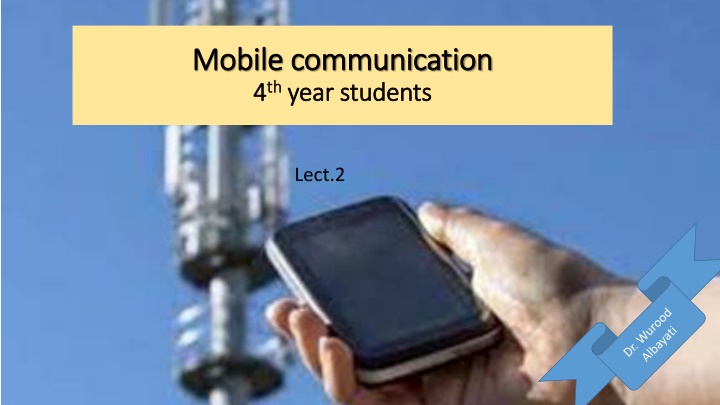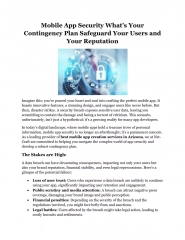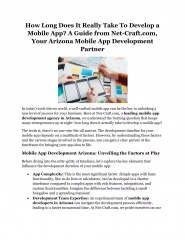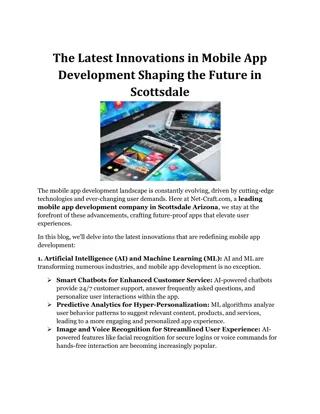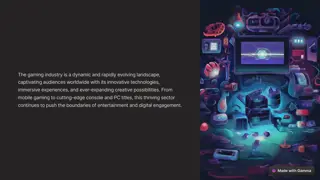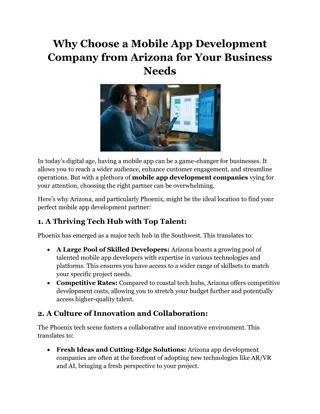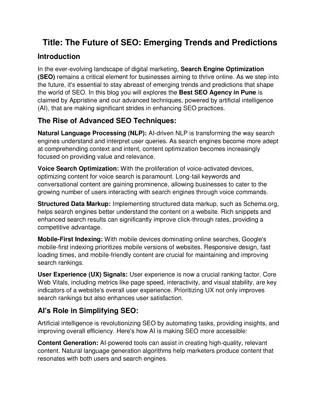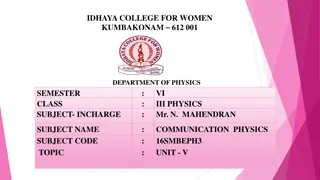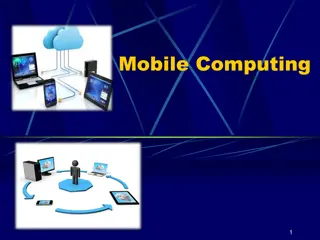Mobile Communication in 4th Year Students Lectures
In lectures for 4th-year students, topics such as mobile communication, network generations, added dimensions of mobile computing, and mobile network systems are covered. The lectures explore the architecture of mobile computing, limitations of early mobile network generations, and the distributed radio system design. Various images illustrate concepts like location awareness, network connectivity, and mobile terminal components.
Uploaded on Mar 17, 2025 | 1 Views
Download Presentation

Please find below an Image/Link to download the presentation.
The content on the website is provided AS IS for your information and personal use only. It may not be sold, licensed, or shared on other websites without obtaining consent from the author.If you encounter any issues during the download, it is possible that the publisher has removed the file from their server.
You are allowed to download the files provided on this website for personal or commercial use, subject to the condition that they are used lawfully. All files are the property of their respective owners.
The content on the website is provided AS IS for your information and personal use only. It may not be sold, licensed, or shared on other websites without obtaining consent from the author.
E N D
Presentation Transcript
Mobile communication Mobile communication 4 4th th year students year students Lect.2
Lect.1 review Added dimensionality Extra dimension of mobile computing Architecture of mobile computing
expensive 1 G 1 G heavy, for corporate and executive use Limitation Poor sound quality; Limited coverage; Full analog mode of communication Low capacity broadband Different 1G systems are incompatible with one another, due to different frequency ranges , No roaming supported between different operators; Weak security on air interface, no support for encryption; No Mobile Assisted Handover and hence more burden on the Mobile Switching Center (MSC)
Mobile network is a distributed radio systems designed so that many users who may or may not be moving around can share a radio band and communicate amongst themselves and to the PSTN. Mobile terminal Airlink Base stations: antennas and their physical supports, containing controllers and radios, called Base Station Transceivers (BST), or Base Transceiver Stations (BTS) and Base Station Transceiver Subsystem (BTS) Home Location Register (HLR) and Visitor Location Register, or in general, Location Register Mobile Telephone Switch Connection to PSTN (Public Switched Telephone Network)
ADDED DIMENSIONS OF MOBILE COMPUTING ADDED DIMENSIONS OF MOBILE COMPUTING 1. location awareness, 2. network connectivity quality of service (QOS), 3. limited device capabilities (particularly storage and CPU), 4. limited power supply, 5. support for a wide variety of user interfaces, 6. platform proliferation, and 7. active transactions 9
Location Location There are two general categories: localization and location sensitivity. Localizationis the adaptation of a product or service to meet the needs of a particular language, culture. Examples of localization include: changing changing z's to s's for British English. Some point-of-sale (POS) systems and e-commerce Web sites are able to take into account the different taxation rules depending on the locale of the sale and the location of the purchase. Thus, localization location sensitivity stationary applications can have, exclusive to mobile applications. Location awareness refers to devices that can passively or actively determine their location. Location sensitivity may include more than just the absolute location of the device. It may also include the location of the device relative to some starting point or a fixed point, some history of past locations, and a variety of calculated values that may be found from the location and the time such as speed and acceleration. 10
Location Location- - Cont. Most location-sensing technologies use one or more of three categories of techniques: Cont. triangulation, Proximity: based methods measure the relative position of the unknown point to some known point. scene analysis : relies on image processing and topographical techniques to calculate the location of the unknown point based on a view of the unknown point from a known point. 11
Location Location Cont. Cont. The most well known location sensing system today is GPS. GPS-enabled devices can obtain latitude and longitude with accuracy of about 1 5 m. GPS has its roots in the military;. GPS devices use triangulation techniques physical mobility affects network connectivity 12
Quality of Service Quality of Service In the case of wireless network connectivity, physical conditions can significantly affect the quality of service (QOS). For example, climate-related conditions (e.g. e, bad weather, solar flares), can negatively affect the (QOS). This unreliability in network connectivity has given rise to the QOS field. The effect of QOS in designing mobile applications is much more deep. Whereas typical nonmobile applications need to know how to stop operating when suddenly disconnected from the network, For example, let us take the mobile applications have to know how to continue to operate even after they are disconnected from the network or while they connect and disconnect from the network frequently. Example: in case of a user who is traveling on a train, is using an application on his tablet( or smartphone) connected wirelessly to some network, and is downloading a work-related report to look over when the train passes through a tunnel and he loses network connectivity. If the application does not have the ability to stop partway through the download process and restart when connectivity is restored, the user may never be able to retrieve the desired file as he passes through one tunnel after the other and the download process starts over and over again. The application, therefore, must know how to deal with lack of reliable connectivity 13
Quality of Service Quality of Service When it comes to taking into account the QOS in most applications, certain functionality is expected of most mobile applications. For example, almost all mobile applications should know how to stop working when the application suddenly disconnects from the network and then resume working when it connects again. Other desired functionality , bandwidth data can be utilized to design applications that dynamically adapt their features and functionality to the available bandwidth. the real-time bandwidth available may be part of the data provided by network operator and refreshed on some time interval. 14
Limited Device Storage and CPU Limited Device Storage and CPU Most useful mobile devices are small. This physical size limitation imposes boundaries on storage, and CPU on mobile devices. Though solid-state engineers are working on putting more and more processing power and storage into smaller and smaller physical volumes. Today s mobile applications are resource-starved. So, it is a sure that memory limitations will be around for a long time for mobile applications because when it comes to mobile systems and devices, smaller is nearly always better. Limitations of storage and CPU of mobile devices put another constraint on how we develop mobile applications. 15
How to overcome device storage challenge in mobile application . 1- Storing information of Cloud or PC. For example, a mobile calendaring application may store some of its data on another node on the network (a PC, server, etc.). The contacts stored on the device may be available at any time. However, the contact information that exists only on the network is not available while the device is disconnected from the network. 2- Some information may be used more frequently than others; for example, the two weeks surrounding the current time may be accessed more frequently in the calendar application or there may be some contacts that are used more frequently. Mobile applications must be designed to optimize the use of data storage and processing power of the device in terms of the application use by the user. the size constraints of the devices limit their storage capabilities 16
Limited Power Supply Limited Power Supply Batteries are the primary power source for mobile devices. Batteries are improving every day and it is tough to find environments where suitable AC power is not available. Yet, often the user is constantly moving and devices are consuming more and more power with processors that have more and more transistors packed into them. The desirability of using batteries instead of an AC power source combined with the size constraints creates another constraint, namely a limited power supply. This constraint must be balanced with the processing power, storage, and size constraints; the battery is typically the largest single source of weight in the mobile. The power supply has a direct or an indirect effect on everything in a mobile device . 17
Extra DIMENSIONS OF MOBILE COMPUTING Extra DIMENSIONS OF MOBILE COMPUTING Varying User Interfaces: Stationary users while they work on PC they use keyboard, mouse, and monitor these efficient user interfaces for stationary device This is not at all true for mobile applications. Mobile uses a combination of interfaces: voice user interfaces, smaller displays, stylus and other pointing devices, touch-screen displays, and miniature keyboards. have proved to be fairly Platform Proliferation(creation): Because mobile devices are small and there is much less hardware in them than in a PC, they are typically less costly to assemble for a manufacturer. This means that more manufacturers can compete in producing these devices. Active Transactions: the stationary applications have a restriction, The user of the system must initiate all interactions with the system. We call such systems passive systems because it is in waiting for some external signal from the user to tell them to start doing some particular thing. active transactions as those transactions initiated by the system. Active transactions may be synchronous or asynchronous. the system has taken an active role in starting communication with the user without having to wait for external user interaction 18
Limitation of Mobile Computing Limitation of Mobile Computing Resource Constraint Interference Bandwidth Changes in communication environment Network issues Interoperability Issues
